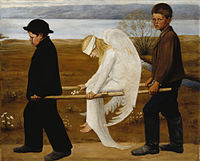Brilliania
Republic of Brilliania Errepublika Brilinako | |
|---|---|
| Motto: Mantendu egingo dugu We will maintain | |
| Anthem: The Three Sailors "Hiru Marinel" | |
| Capital | Hegoalde |
| Largest | Akerrau |
| Official languages | Brillian, Fiarakent (Iparinan dialect) |
| Ethnic groups (2017) | |
| Demonym(s) | Brillian |
| Government | Unitary dominant-party presidential republic |
• Lehendakari (President) | vacant |
• Vice President | vacant |
| Independence from the Aeian Socialist Union 1981 | |
• Unification of Brillian territories | 964 |
• Introduction of Alydianism and end of isolation | 1676 |
• Assasination of Prince Ilurdo | 1931 |
• ASU takes over | during GW2 |
• Proclamation of Independence held | 1979 |
• Blue Revolution | 2000 |
| Population | |
• 2017 census | 16,518,815 |
| GDP (PPP) | 2017 estimate |
• Total | $487,998,832,730 |
• Per capita | $29,542 |
| GDP (nominal) | 2017 estimate |
• Total | $395,873,401,475 |
• Per capita | $23,965 |
| Gini (2016) | medium |
| HDI (2017) | very high |
| Currency | Brillian Florrin (BFL) |
| Time zone | UTC+2 (Eastern Asuran) |
• Summer (DST) | +3 |
| Date format | yyyy-mm-dd |
| Driving side | right |
| ISO 3166 code | BR |
| Internet TLD | .brl |
Brilliania (Brillian: Brilinako), officially the Republic of Brilliania, formerly the Brillian Republic (Brillian: Errepublika Brilinako) is a sovereign state in Eastern Asura bordered by the Gulf of Sclavonia and the nations of Miersa, Veleaz and Dreyvisevich. Brilliania consists of 10 provinces, 9 regular provinces and the specially administered capital of Hegoalde. It is an unitary semi-presidential republic with around 16.5 million inhabitants. Ethnic Brillian people, which speak the isolated Brillian language make up 79% of the population, with a significant minority of Iparinans from the southeastern region of Iparina.
The territory of Brilliania has been populated for several thousand years, with the first evidence of civilization being traced to 3000 years ago. The ancient Herritxa civilization existed until 600 BC. The language which was spoken by the Herritxa civilization is currently still unknown.
Brilliania was pagan until the 11th century, practising a religion called Marism. Alydianism was introduced by western Alydian crusaders, in the form of Orthodox Alydianism. It was partially supplanted in the 17th century by Puritan Alydianism because of Veleazan missionarries. The contact with Veleazan missionaries caused an exchange of Veleazan words in the Brillian language while Brillian words also entered into Veleazan.
Brilliania was ruled by a monarchy for almost a thousand years, starting when Prince Ganiz unified several Brillian towns in the year 964, and ending with the execution of Prince Ilurdo by communists in 1931. However, the Prince became mostly ceremonial in 1887, with the creation of the first parliament of Brilliania. The parliament was unique in the fact that every adult man was able to vote in elections, although women were never enfranchised.
In 1933, profiting from the anarchy started by Prince Ilurdo's execution, and a bombing on the Parliament while it was in session, the Aeian Socialist Union and communist militia succesfully conquered Brilliania. This started 46 years of oppression by the communists, with the execution of up to 14,000 prominent individuals.
Independence was proclaimed on the 6th of December in the year 1979, causing the Brillian government in exile to join the secessionist side in the ASU Civil War. The Civil War was bloody, with 15,000 people, mostly civilians, dying. One of the most prominent murders in the ASU Civil War were the Defenestrations from Akerrau, where Communist spies in Asura killed 15 diplomats in embassies of the in-exile government of the Republic of Brilliania by throwing them out of windows.
After the Civil War, Brillian independence was internationally recognized. Brilliania is a developed country with a high-income service-based economy, which grew massively between 2002 and 2015 during the "Brillian Boom". It ranks very highly in the Human Development Index. Brillian citizens have a high quality of life, assisted by massive technology investments since the Blue Revolution, low-cost education and a state healthcare system . Despite governmental investments in social security, income inequality is high, with a medium ranking for Gini.
History
Before 964
- Iparinan migration from the north - many rivalling tribes/cities
Princedom of Brilliania (964 - 1933)
- Prince Ganiz unifies tribes - Some small wars with neighbours, nothing major - Some feuds between dynasties as well - Unsuccesful attempts at conversion to Alydianism - Missionaries from Veleaz introduce Puritan Alydianism - Princedom ends with regicide
ASU occupation (1933 - 1979)
- short civil war between commies (taking the opportunity), republicans and conservatives, commies assisted by ASU win - seperatists proclaim independence in 1979 during start of asu civil war - provisional government formed for 3 years
Republic of Brilliania (1979- current)
After the ASU Civil War ended, Brilliania started its transition to democracy. The start of the transition included economic problems including hyperinflation. The ceremonial renaming of the city of Sirizio (named after the first president of the Brillian Soviet) to Martiriren Herria (Town of Martyrs) marked the symbolic end of socialism in Brilliania.
Geography
Brilliania is a relatively low-lying country, with parts of the northern coast being below sea level. The southern parts are hillier, including the capital city of Hegoalde. The average national elevation is around 30 metres. The highest point of Brilliania is the 560-metre high Saran Peak, which is close to Hegoalde. The Saran Peak is easily climbable and is a popular spot for tourists. Hegoalde itself is one of the highest-elevated cities in Brilliania, being around 350 metres high.
Climate
Environment
Politics and Government
| Template:BrillianiaMuntaia |
The Legebiltzarrak
The Legebiltzarrak is the unicameral legislature of the republic of Brilliania. It consists of exactly 200 members which are elected using party-list proportional representation using the Sainte-Laguë method of proportional representation. The Lehendakari is allowed to make law proposals and parliamentary motions, the latter only if he is physically in the Parliament.
10 MPs, or the Lehendakari alone, may propose a parliamentary motion to expel a member if he breaks parliamentary protocol. The most recent parliamentary motion for expellation of a MP was on 11 October 2018, when 197 MPs voted in favour of a presidentiaal motion to expel the Patriots MP Martitz Urdaki after he expressed his sympathy towards the culprit of the 2018 Jakóbgard attacks.
Since 2002, the parliamentary rules have included provisions for a weekly parliamentary question session for the Lehendakari, according to Midrasian standard.
Military
Foreign Relations
Economy
Energy
Industry
Infrastructure
Transport
Demographics
According to the most recent national census, a total of around 16.5 million people live in the Republic of Brilliania. Most citizens live in Kostaldea, Hiriburuko Auzoa and Iparina provinces. The largest city is Akerrau, which houses around 2.7 million people and was the former capital of Brilliania until 1950. The capital city is Hegoalde, which is administered as a province called Hiriburuko Auzoa which is an enclave fully in Iparina province.
Brilliania is considered a relatively homogenous nation, with the most major groups being the Brillians and the Iparinans. Other minorites include Sclavonics, Veleazans and Miersans, with the latter two mostly consisting of refugees from regional tensions.
Template:BrillianCities
Education
Education in Brilliania consists almost fully of public education, with standards being created by the Ministry of Education. Preschool is optional but highly recommended, and 97% of Brillian children between the ages of 3 and 6 attend preschool. Schooling generally starts at age 7 and is mandatory until the age of 17. At the age of 12, students must do the EPA exam which decides which of the 3 levels of secundary education a child will go to.
The three levels of secondary education in Brilliania are called Lower Secondary, Middle Secondary and Higher Secondary. Lower Secondary is a form of vocational education and prepares a student for future work. It takes 3 years and exams are performed at the age of 15.
Middle Secondary is a form of education mostly meant for preparation for future education or work. It takes 4 years and exams are performed at the age of 16.
Higher Secondary is the most prestigious form of secondary education. It prepares a student for the Matura and university-level tertiary education. It takes 5 years. Higher Secondary students are given Matura at the age of 17.
Brillian education is well-known for being one of the strictest in Asura; there are heavy punishments for truancy and there are very strict dress code laws.
Religion
Religion in Brilliania (2016)
Culture
Music
Brilliania has had several musical developments in its history. A very common type of Brillian music is the "Bizitza kantua" (Life song). These life songs often are about subjects of lost ones or loneliness. They have a simple melody and a straightforward musical structure. A common element in life songs are accordions and guitars. Despite the cultural liberalization since Brillian independence, they are still very popular.
Brillian independence in the 80's caused cultural liberalization which is also marked in Brillian music. Music moved in a more positive way, shifting away from tradition and moving into internationalized territory with songs by bands such as Bonba becoming huge hits in Brilliania. The shift to internationalized music has reversed in recent years, with most modern songs having folk influences and international pop is shunned. Controversially, in 2013 a conservative majority in the parliament voted for a bill which mandated that radio stations must not broadcast more than 1 hour of pop music each day to prevent the brain-washing of youth.
Despite the general lack of internalization in Brillian pop music, other foreign music styles such as jazz are popular. The jazz singer Salbatzaile Tzobiral gained international praise in 2016 after winning the Aeiavision Song Contest with his self-penned song "Maitasuna Bai". Rock and metal are also popular international music genres in Brilliania, although artists making music in these genres have recieved severe opposition from religious organizations for promoting atheism.
Cuisine
Cuisine is a big part of the Brillian culture, with cooking being regarded as a communal event especially at special occasions. Brillian cuisine is influenced by both neighbouring cultures and geographical influences. In the Kostaldea province fish dishes are widespread, while in the south meat is preferred. Iparinan cuisine is influenced by Brillian culture and vice-versa. An example of Iparinan-Brillian cuisine is Erreta, which is a beef stew with simple ingredients, mostly consisting of beef, paprika and onions which is stewed in a large pot over a fire. The import of paprika's via Veleazan new-world colonies have added a big element to Iparinan cuisine.
A common occurrence in Brilliania are the so-called txoko, which are closed gastronomical societies for men. Txokos doubled as speakeasies during ASU rule - the communist government in Brilliania did not monitor txokos. Most txokos have their own constitutions featuring rules the members must agree to. Txokos are very common institutions: The city of Hegoalde, with more than 2 million citizens, has over 1,500 txokos with over 200,000 members in total. Most txokos are very conservative - traditional clothing is required and women are banned from entering because cooking is often regarded as a male activity in Brilliania. In recent years the so-called txoko sozialak, or social txoko, have been started in most major cities. Social txokos allow women, and have liberal dress codes. Txokos are also a common place for political debates.



